Acer R7 Review: Something Different
by Jarred Walton on August 15, 2013 12:45 AM ESTI’m going to stuff all of the benchmarks onto one page for this review; there’s really nothing noteworthy about the performance of the R7, at least on the CPU and graphics side of things. Battery life and display quality are a bit more important, but given the timeliness of this review (or the lack thereof), most of what we wanted to say was covered on the previous pages. So, here are the benchmarks, using our updated 2013 mobility suite. I’ll save a bit of short commentary for after the break.
First, here’s a quick overview of the laptops we’re including in our graphs. With the update to our 2013 mobile test suite, we’re somewhat at the mercy of our results database. Most of our comparisons that are meaningful are going to be with Ultrabooks, and given that were dealing with basically Ultrabook hardware the Acer R7 posts similar performance. We tossed in the MSI GX60 Richland APU notebook as a comparison, not because the notebooks are similar but because the A10-5750 APU more or less competes with Ivy Bridge ULV processors. Note that we did not run every benchmark on every laptop, so some charts might be missing certain laptops.
| Specifications of Benchmarked Laptops | ||||||
| Laptop | CPU | GPU | Storage | RAM | LCD | Battery |
| Acer R7-571-6858 | Intel Core i5-3317U | HD 4000 | 500GB HDD + 24GB SSD | 1x4GB + 1x2GB | 15.6” 1080p Glossy AHVA Touchscreen | 4-cell 54Wh |
| Acer S7-391-9886 | Intel Core i7-3517U | HD 4000 | 2x128GB RAID 0 SSDs | 2x2GB | 13.3” 1080p Glossy IPS Touchscreen | 4-cell 35Wh |
| Acer S7-392-9890 (Preview) | Intel Core i7-4500U | HD 4400 | 2x128GB RAID 0 SSDs | 2x4GB | 13.3” 1080p Glossy IPS Touchscreen | 4-cell 46Wh |
| AMD Kabini | AMD A4-5000M | HD 8330 | 256GB SSD | 1x4GB | 14” 1080p Matte IPS | 4-cell 45Wh |
| Apple MacBook Air 13 (2013) | Intel Core i5-4250U | HD 5000 | 128GB SSD | 2x2GB | 13.3” 1440x900 Glossy TN | 4-cell 54Wh |
| Clevo W550EU (Mythlogic) | Intel Core i5-3340M | HD 4000 | 256GB SSD | 2x4GB | 15.6” 1080p Matte IPS | 6-cell 62-Wh |
| HP Spectre XT TouchSmart | Intel core i7-3517U | HD 4000 | 500GB HDD + 32GB SSD | 2x4GB | 15.6” 1080p Glossy IPS Touchscreen | 4-cell 48Wh |
| Lenovo ThinkPad X1 Carbon | Intel Core i5-3427U | HD 4000 | 180GB SSD | 2x2GB | 14” 1600x900 Glossy TN Touchscreen | 4-cell 45Wh |
| MSI GE40 | Intel Core i7-4702MQ | HD 4600 / GTX 760M | 128GB SSD + 750GB HDD | 1x8GB | 14” 1600x900 Matte TN | 6-cell 65Wh |
| MSI GX60 | AMD A10-5750 | HD 8650G | 750GB HDD | 1x8GB | 15.6” 1080p Matte TN | 9-cell 87Wh |
| Toshiba KIRAbook | Intel Core i7-3537U | HD 4000 | 256GB SSD | 2x4GB | 13.3” 2560x1440 Glossy IPS Touchscreen | 4-cell 52Wh |
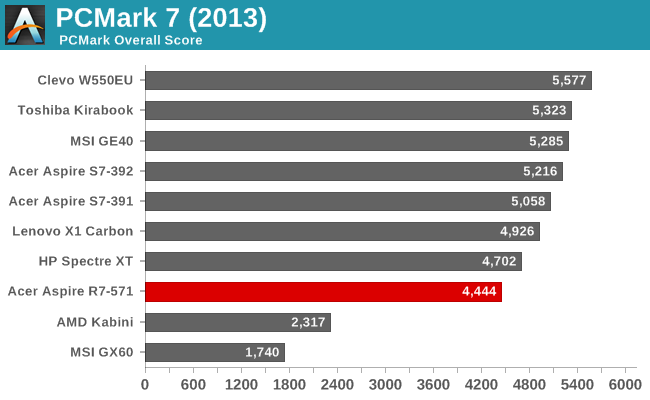
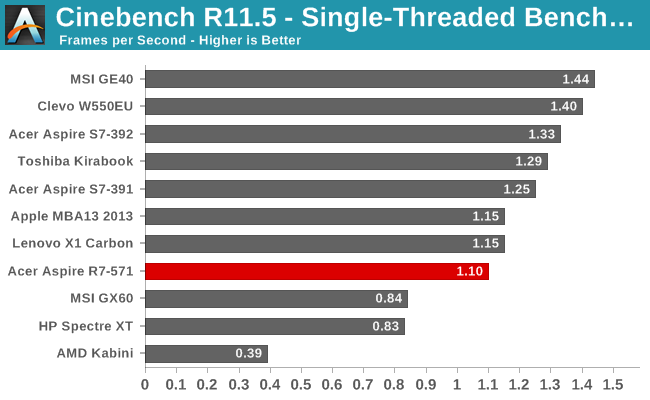
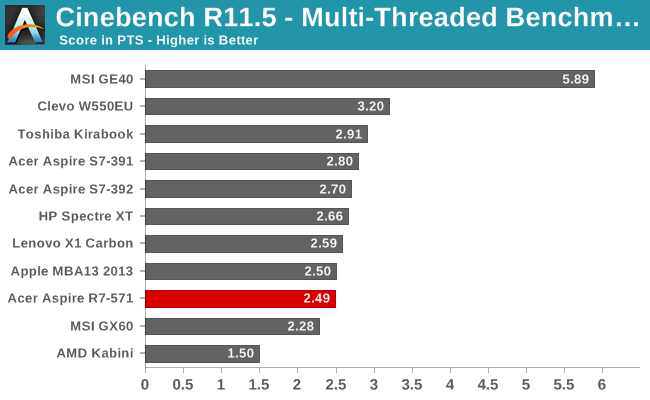
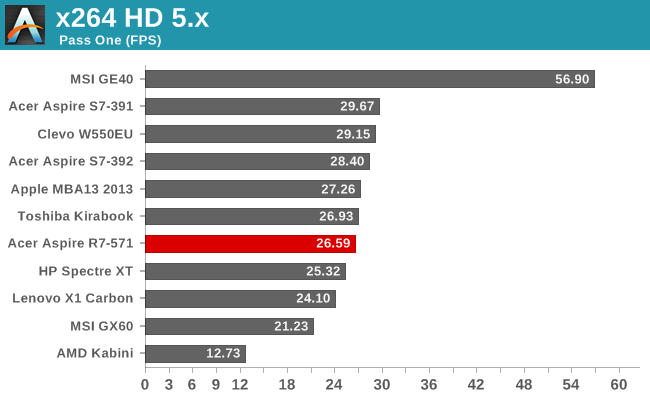
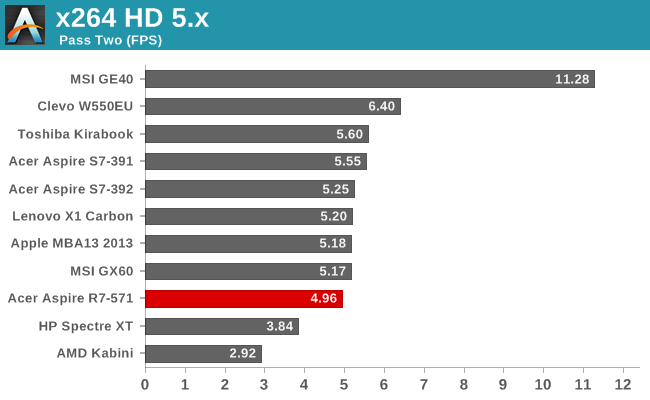
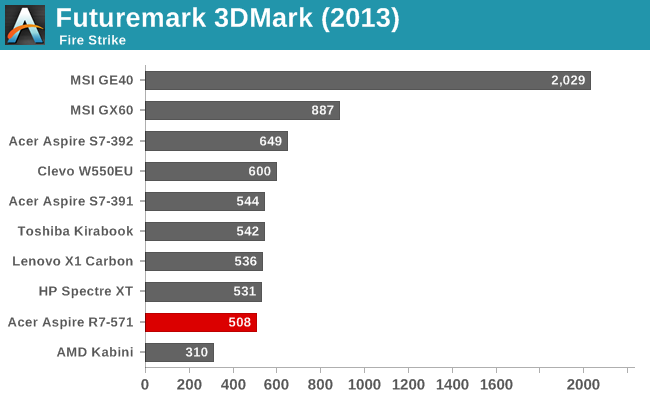


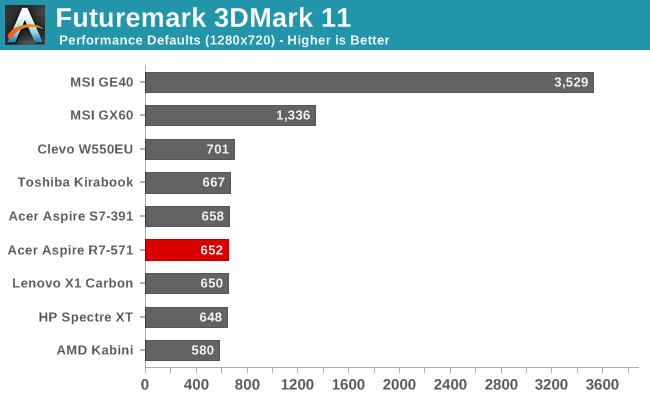
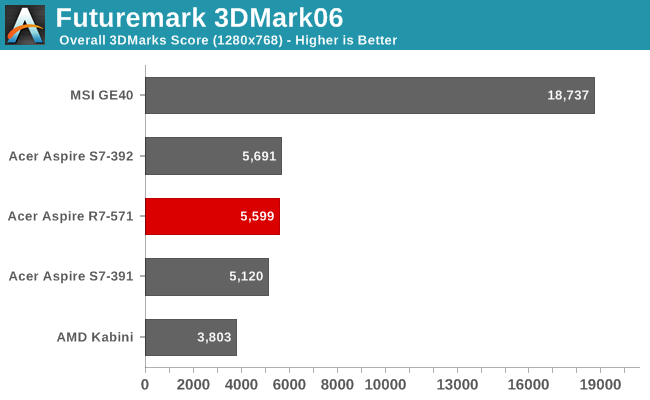

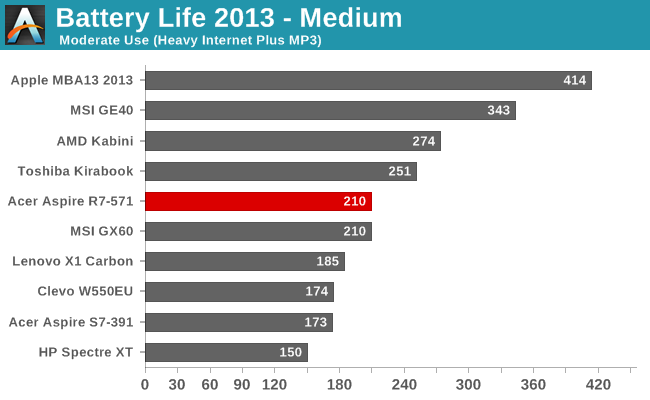
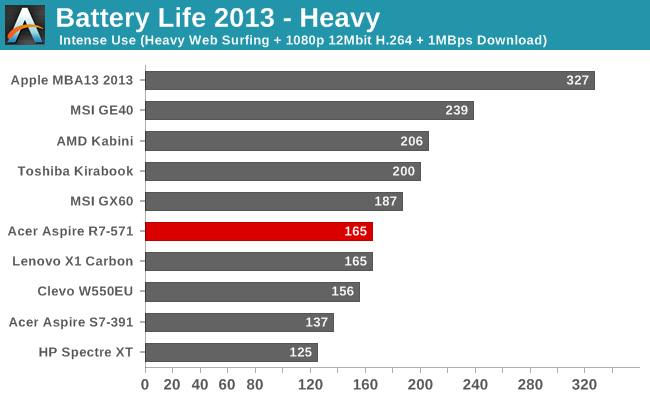
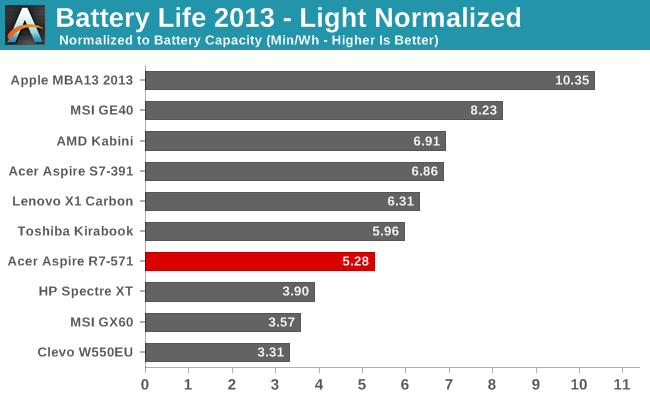
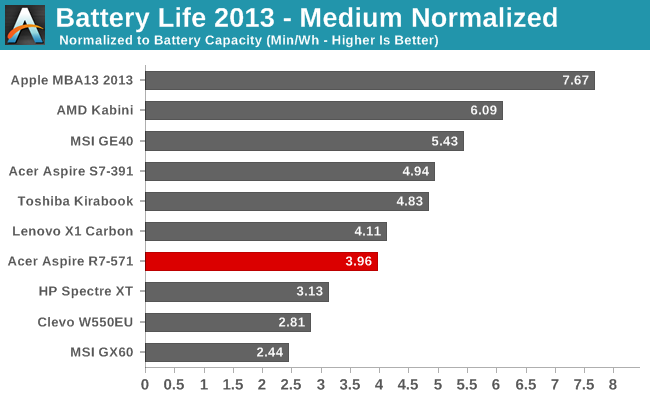
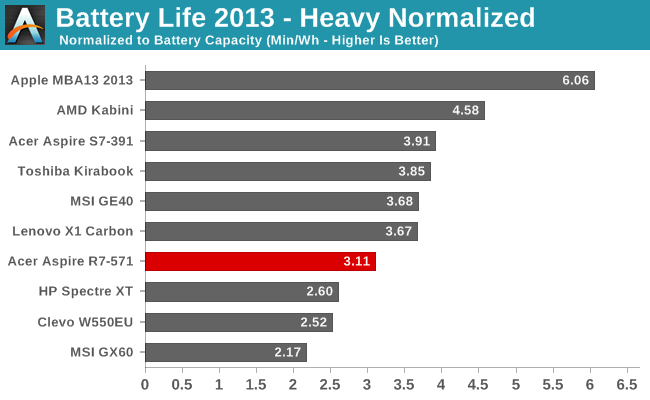
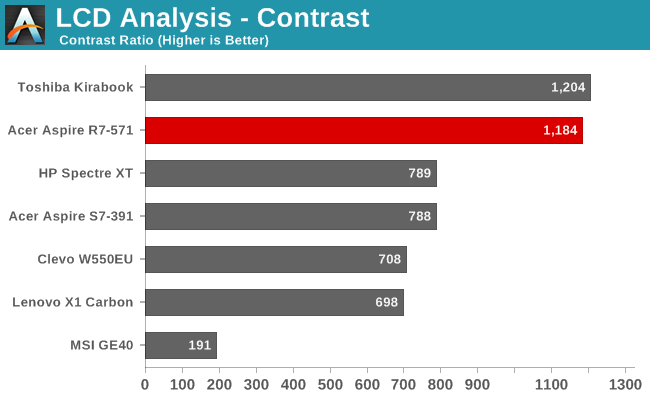

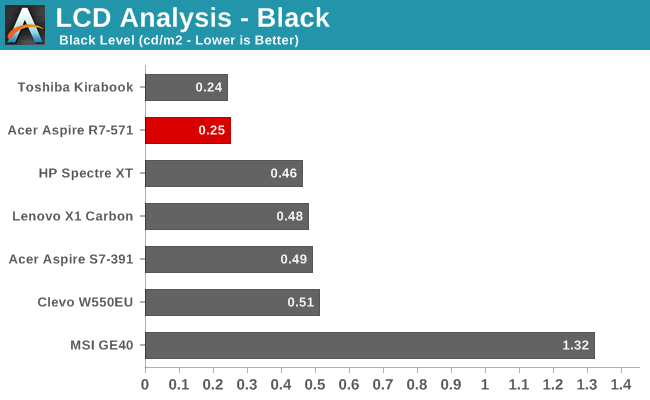
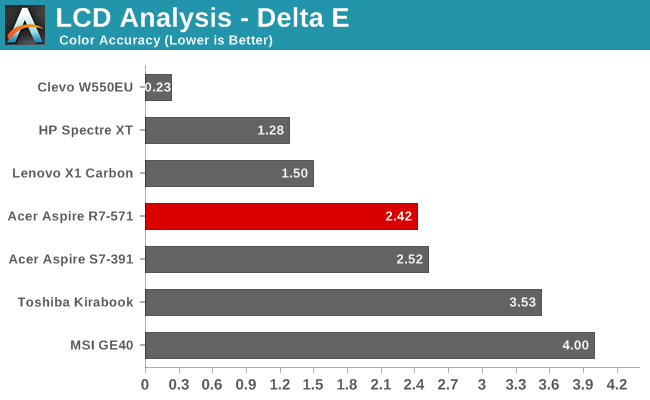
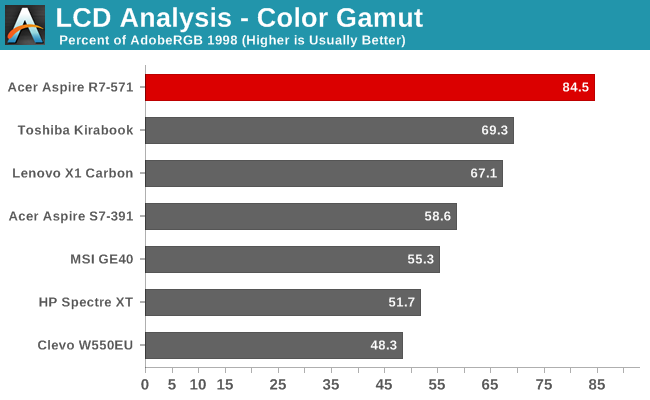
Whew! That’s a lot of benchmarks, and there are even more results in Mobile Bench – like if you really want to know how the R7 handles our gaming suite, for example, it’s there! If you don’t want to look but want a short summary, only one game gets above 10FPS at the Enthusiast settings, and just barely; with Mainstream most of the games fall in the 10-20FPS range, so basically unplayable. Even our Value gaming settings are mostly too much for the HD 4000, though most of the Windows 8 games in the Store are far less demanding and will run just fine – no surprise given most of those are targeting Windows RT, which means GPUs that are often less than half as fast as the HD 4000.
Elsewhere, CPU performance is about where you’d expect it: lower than Core i7 ULV/ULT, and similar to other Core i5 ULV parts. The hybrid storage solution means that PCMark7 doesn’t score quite as well as pure SSDs, but it’s still a huge step up from what you’d get from a pure HDD setup (e.g. GX60). Since I just mentioned the GX60, it’s also interesting to note that Core i5 ULV generally posts better CPU performance than AMD’s Richland APUs – though the second pass of x264 HD at least put AMD slightly ahead. GPU performance is nothing to write home about; it’s more than sufficient for running most Windows tasks, but anything graphically intensive is best off served by a dedicated GPU (or at the very least Intel’s Iris HD Graphics Iris Pro).
Battery life isn’t particularly stellar, but we’ve also seen worse – sometimes much worse. Realistically, four hours of light use is possible off a single charge, while heavier workloads will bring you closer to 2.5 hours. That puts the R7 slightly ahead of the Lenovo X1 Carbon in most tests, but only thanks to its higher battery capacity. In terms of normalized battery life, the R7 places fourth from last of the tested notebooks, and given that Clevo typically doesn’t optimized very well for power use and the MSI GX60 is classified as a gaming notebook, only the win over the HP Spectre XT TouchSmart is really worth mentioning. When we start to look at Haswell-based notebooks, even though Ivy Bridge was pretty good it looks pretty poor in light of what’s now available. Apple’s MacBook Air 13 runs at different OS, but the MSI GE40 has a quad-core Haswell CPU and a slightly larger battery, with about 50% more battery life than the Acer R7.
Wrapping up the benchmarks, as I mentioned before, the one standout item in the R7 is the display. Contrast is excellent, and color quality is at least decent – the 85% color gamut is actually a bit overblown, however, as some of the colors are actually outside of the Adobe RGB 1998 color space while others fall far short (green in particular is lacking). Still, the great viewing angles offered by AHVA combined with good overall performance definitely deserve commendation.










113 Comments
View All Comments
safcman84 - Friday, August 16, 2013 - link
If Acer had gone for Win RT, then you be fair to compare to tablets. However this hybrid-ultrabook isnt competing in the same market. This is not a consumer tablet deviceIf Acer had gone for iOS or Android it wouldnt be able to run full desktop apps, and therefore would lose its appeal to the market it is aiming for.
You wont see the full impact of Win8 for another year/year and a half. The company I work at (120k employees globally) is rolling out win8 next year and abandoning the iPads it started to roll out last year. Why? cos iOS cannot handle the applications that win8 can, and they want their workstations, laptops, phones, laptops etc to run the same ecosystem so business users dont have to learn how to use 3 seperate OSes
JarredWalton - Friday, August 16, 2013 - link
Except, they'll still potentially have three different OSes:Windows 8.1 for desktops/laptops and expensive tablets
Windows RT for inexpensive tablets, unable to run full Windows applications
Windows Phone, which is another separate platform.
So unless they only go with full Windows 8.1 devices, they'll still face a fragmented set of platforms, and the phones and RT devices will need new apps, and using RT and Phone is not the same as using Windows any more than iOS and OS X are the same.
bearinthevalley - Friday, August 23, 2013 - link
hmm then you should work at a better company. the one i work at with 70k employees allows its employees to choose any platform he/she wants. it's called "any device" or "bring your own device" concept. we don't live in an age where corporate IT has to heavyhandly force devices and platforms on its users, but rather empowering its employees to be efficient and productive in the platform/device/OS they personally prefer. it's proven that employees are far more productive and satisfied if they could choose their own devices. hence if you come to our office you will see a diverse ecosystem of devices coexisting, from thinkpad to ipad, from macbook air to retina pro, from surface to android, you can use anything and all our corporate apps will just work (ideally at least)gxtoast - Wednesday, August 21, 2013 - link
I think that it should be noted just how immature Windows 8 Metro is as an OS and as a platform for touch centric applications. I think, as an OS, it is pretty good and can certainly keep up with IOS and Android. However, usability is a key aspect in the new touch world and Microsoft is struggling to adopt this new requirement.If you take a look at Apple it becomes clear that they have made usability the centerpiece of their OSes. From this position they have encouraged, through marketing and culture, all of their developers to match or better any Apple usability innovation.
It remains to be seen whether Microsoft can fully embrace and realize usability in their own applications and OS, and push their developers to do the same.
I've been using Windows for a long time and have recently come back to the Apple eco-system looking for a range of apps. What I have discovered is that most Apple applications have a refinement and usability excellence that just isn't present in the majority of Windows apps. It is quite astounding, actually. Apple developers just seem to go deeply into usability and produce beautiful user interfaces that ooze fuctionality. Windows is very clearly playing catchup in this way.
Another misstep that Microsoft has made, and I think it is a major one, is their INSISTENCE of a 16:9 display ratio for all Windows 8 devices. This is THE biggest reason why my next tablet will be an iPad and NOT a Windows tablet. Microsoft talks about Content Creation, but their insistence on 16:9 puts them squarely in the Content Consumption category. A big fail I think.
MrSpadge - Saturday, August 24, 2013 - link
But we're comparing the products here, not what the market thinks, don't we? Your task as a reviewer is not to say "people have not bought it in masses, so it can't be good" but rather "This and this are the strengths of the product, whereas these are weaknesses. It's worth buying in this and this scenario, but not in that one."themossie - Thursday, August 15, 2013 - link
FWIW, I still have yet to meet anyone who uses the touchscreen on their laptop -and- runs Windows 8.Most professionals who need a touchscreen for their work don't benefit from Windows 8.
Most (not all) consumers don't see the value proposition in paying more for it.
Those consumers who do see the benefit of a touchscreen tend to just buy an Android/iOS
tablet
damianrobertjones - Thursday, August 15, 2013 - link
This does not make sense. I've seen people using keyboards with their ipads and you'd bet that if they had a mouse they'd not be touching the screen. Think about it... . I have a Dell 24" touchscreen in front of me... Do I 'touch' the screen? No. Why buy it then? BECAUSE I CAN.themossie - Thursday, August 15, 2013 - link
Kinda confused by this post...Plenty of consumers use iPads as their primary computer device, so they end up buying a keyboard. This is cheaper, lighter, easier to use (for light consumer workloads) and has a lot more touch apps than a good lightweight touch Win8 laptop.
Why would they use a mouse with it? Have you seen anyone use a mouse with an iPad? I haven't tried it, but with an Android tablet a mouse is a miserable experience - because everything's designed for touch.
Buy a 24" touchscreen you don't touch "because you can"? Huh? Isn't that >2x the regular price for a feature you won't use?
karasaj - Thursday, August 15, 2013 - link
To be fair the first year of android tablet sales weren't exactly spectacular. It wasn't until the kindle fire that they really began to catch on. And I think windows 8 is a better tablet OS than android was back then with its 6 android tablet optimized apps... So its quite possible 8.1 and $200 tablets could help a lot.Microsofts issue is charging $90 for an OS in a world where all of the other major competitors provide it for free. That eats into an OEMs margins, which either drives the price up or makes them unwilling to adopt. It HAS to be cheaper or free. Like, $10.
nafhan - Thursday, August 15, 2013 - link
I'm curious what you mean by "fully functional". Runs windows apps?